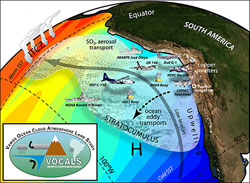Oct 6 2008
During October and November 2008, some 150 scientists from 40 institutions in eight nations - including scientists from the U.S. Department of Energy’s (DOE) Brookhaven National Laboratory - will take part in an international field experiment designed to make observations of critical components of the climate system of the southeastern Pacific.
 Schematic of the Variability of the American Monsoon Systems (VAMOS) Ocean-Cloud-Atmosphere-Land Study Regional Experiment (VOCAL-REx). The figure also shows the locations of extended observational buoys: the Improved Meterology (IMET) buoy and the Servicio Hidrografico y Oceanografico de la Armada de Chile (SHOA) buoy. ITCZ is the Intertropical Convergence Zone.
Schematic of the Variability of the American Monsoon Systems (VAMOS) Ocean-Cloud-Atmosphere-Land Study Regional Experiment (VOCAL-REx). The figure also shows the locations of extended observational buoys: the Improved Meterology (IMET) buoy and the Servicio Hidrografico y Oceanografico de la Armada de Chile (SHOA) buoy. ITCZ is the Intertropical Convergence Zone.
Because elements of this system are poorly understood and poorly represented in global climate models, collecting real-time, complementary data from a variety of areas will go a long way toward improving scientists’ ability to use these models for making accurate predictions about Earth’s climate.
A total of five aircraft — including DOE’s G-1 Gulfstream research aircraft, operated by Pacific Northwest National Laboratory (PNNL) with instruments developed at both PNNL and Brookhaven — and two research ships will sample the lower atmosphere and upper ocean during the experiment. Two sampling sites operated by research groups from Chile, Sweden, and the United States with conduct complementary sampling studies in the coastal region of Chile south of Santiago.
“We are motivated to participate in this study because the vast area of clouds in this region will provide an ideal laboratory for testing theories that have been developed at Brookhaven Lab regarding how precipitation forms in clouds and how aerosols affect cloud optical and microphysical properties,” said Brookhaven chemist Peter Daum, chief DOE scientist for the study.
The southeastern Pacific region is dominated by strong coastal upwelling, bringing cold, dense seawater from the deep ocean closer to the surface and resulting in extensive cold sea surface temperatures. It is also home to the largest subtropical deck of low-lying stratocumulus clouds on Earth.
“These and other chemical and physical factors shape the regional climate and affect the global weather in ways that are poorly understood,” said C. Roberto Mechoso, a professor of atmospheric and oceanic sciences at the University of California, Los Angeles, who chairs the research program. “Our research should produce a better understanding of the Southeast Pacific Ocean system, and improve our global computer climate models —which would lead to more confidence in climate forecasts, including predictions about global warming.”
Mechoso heads the scientific modeling arm of the research program, while Robert Wood, assistant professor of atmospheric sciences at the University of Washington, will lead the experimental field component.
Specifically, the scientists will focus on gaining a better understanding of:
- the processes that control the properties of stratocumulus clouds – including the influence of tiny aerosol particles emitted from smelters and volcanoes located on the South American continent
- the processes that control the transport of cold freshwater in the ocean
- the chemical and physical interactions between the lower atmosphere and upper ocean
The study is known as the Variability of the American Monsoon Systems’ (VAMOS) Ocean-Cloud-Atmosphere-Land Study Regional Experiment (VOCALS-Rex). It is a component of a larger international climate study program, VOCALS. The major goal of the VOCALS program is develop and promote scientific activities leading to improved understanding, model simulation, and predictions of the southeastern Pacific ocean-atmosphere-land climate system on day-to-day and year-to-year timescales.
The other major components of VOCALS are a modeling program ranging from local to global scales and a suite of extended observations from regular research cruises, instrumented moorings, and satellites.
The combination of intensive field measurements, long-term observations, and modeling will provide important insights that could directly benefit climate modeling, the researchers say.
For more information about the study, visit: http://www.eol.ucar.edu/projects/vocals/ and http://www.newsroom.ucla.edu/portal/ucla/southeastern-pacific-ocean-research-40753.aspx.
Brookhaven Lab’s role in this research was funded by DOE’s Office of Science. VOCALS-REx receives additional support and participation from the National Oceanic and Atmospheric Administration (NOAA), the National Science Foundation, and the World Climate Research Program.